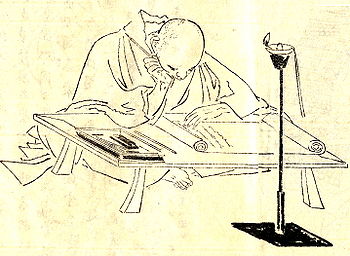
Tsurezuregusa
Encyclopedia

Yoshida Kenko
was a Japanese author and Buddhist monk. His most famous work is "Tsurezuregusa" , one of the most studied works of medieval Japanese literature. Kenko wrote during the Muromachi and Kamakura periods.-Life and work:...
between 1330 and 1332. The work is widely considered a gem of medieval Japanese literature and one of the three representative works of the zuihitsu
Zuihitsu
is a genre of Japanese literature consisting of loosely connected personal essays and fragmented ideas that typically respond to the author's surroundings...
genre
Literary genre
A literary genre is a category of literary composition. Genres may be determined by literary technique, tone, content, or even length. Genre should not be confused with age category, by which literature may be classified as either adult, young-adult, or children's. They also must not be confused...
, along with Makura no Sōshi
The Pillow Book
is a book of observations and musings recorded by Sei Shōnagon during her time as court lady to Empress Consort Teishi during the 990s and early 11th century in Heian Japan. The book was completed in the year 1002....
and the Hōjōki
Hojoki
, variously translated as "An Account of My Hut" or "The Ten Foot Square Hut", is an important short work of the Kamakura period in Japan by Kamo no Chōmei. Written in 1212, it describes disasters that befall the people of Kyoto from earthquakes to famine and fire...
.
Tsurezuregusa comprises a preface and 243 passages (段, dan), varying in length from a single line to a few pages. Kenkō, being a Buddhist
Buddhism
Buddhism is a religion and philosophy encompassing a variety of traditions, beliefs and practices, largely based on teachings attributed to Siddhartha Gautama, commonly known as the Buddha . The Buddha lived and taught in the northeastern Indian subcontinent some time between the 6th and 4th...
monk, writes about Buddhist truths, and themes such as death
Death
Death is the permanent termination of the biological functions that sustain a living organism. Phenomena which commonly bring about death include old age, predation, malnutrition, disease, and accidents or trauma resulting in terminal injury....
and impermanence
Impermanence
Impermanence is one of the essential doctrines or three marks of existence in Buddhism...
prevail in the work, although it also contains passages devoted to the beauty of nature as well as some on humorous incidents. The original work was not divided or numbered; the division can be traced to the 17th century.
The work takes its name from its preface passage:
つれづれなるまゝに、日暮らし、硯にむかひて、心にうつりゆくよしなし事を、そこはかとなく書きつくれば、あやしうこそものぐるほしけれ。
Tsurezurenaru mama ni, hikurashi, suzuri ni mukaite, kokoro ni utsuriyuku yoshinashigoto wo, sokowakatonaku kakitsukureba, ayashū koso monoguruoshikere.
In Keene's
Donald Keene
Donald Lawrence Keene is a Japanologist, scholar, teacher, writer, translator and interpreter of Japanese literature and culture. Keene was University Professor Emeritus and Shincho Professor Emeritus of Japanese Literature at Columbia University, where he taught for over fifty years...
translation:
What a strange, demented feeling it gives me when I realise I have spent whole days before this inkstone, with nothing better to do, jotting down at random whatever nonsensical thoughts that have entered my head.
where つれづれ (tsurezure) means “having nothing to do.”
For comparison, Sansom
George Bailey Sansom
Sir George Bailey Sansom was a historian of pre-modern Japan particularly noted for his historical surveys and attention to Japanese society....
's translation:
To while away the idle hours, seated the livelong day before the inkslab, by jotting down without order or purpose whatever trifling thoughts pass through my mind, truly this is a queer and crazy thing to do!
Translations
The definitive English translation is by Donald KeeneDonald Keene
Donald Lawrence Keene is a Japanologist, scholar, teacher, writer, translator and interpreter of Japanese literature and culture. Keene was University Professor Emeritus and Shincho Professor Emeritus of Japanese Literature at Columbia University, where he taught for over fifty years...
(1967). In his preface Keene states that of the six or so earlier translations into English and German, that by G. B. Sansom
George Bailey Sansom
Sir George Bailey Sansom was a historian of pre-modern Japan particularly noted for his historical surveys and attention to Japanese society....
is most distinguished. It was published by the Asiatic Society of Japan in 1911 as The Tsuredzure Gusa of Yoshida No Kaneyoshi. Being the meditations of a recluse in the 14th Century. A scan of a 1914 translation by Porter is included among the links below.
External links
- The full Japanese text of Tsurezuregusa, with translation into modern Japanese
- English excerpts of Tsurezuregusa. Sansom's translation
- Scanned whole book of English translation by William N. Porter (1914)
- Reading of "Tsurezuregusa"
Footnote
- literally, “as the brush moves,” i.e., jotting down whatever comes to one's mind, usually translated “essay.”

